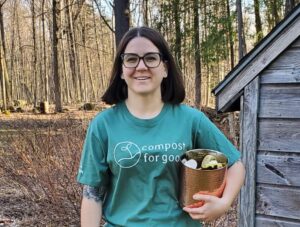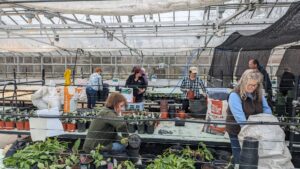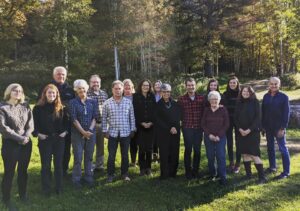AdkAction projects range from expanding broadband access and addressing the housing crisis to protecting our water from road salt to community art festivals. While our projects are distinct, they do not operate in siloes. One example is the interplay between three projects associated with local food systems: our Adirondack Pollinator Project works to expand habitat for the insects that pollinate our crops, our Food Security Project supports local farms feeding Adirondack residents, and our Compost for Good project uses food scraps and other organic materials to restore the soils that grow food for humans and pollinators alike.
At the intersection between Compost and Pollinators, John Culpepper of Compost for Good asks “Can our lawns help reverse the decline in pollinator biodiversity?”
I love beautifully manicured lawns. Especially well-maintained grass swards associated with large estates, golf courses, and public parks. When working on my degree in Ornamental Horticulture and Landscape Design, I sat in a lecture where the professor talked about how most of us feel this way, and that it has to do with the fact that humans evolved in savannah landscapes. That feeling is somehow ingrained in many of us.
However, as I’ve grown older, I’ve realized that large areas of grass, as beautiful as they are, don’t support very many insects and birds, and therefore, other wildlife.
You may have heard about the importance of pollinators, and their enormous benefit to our natural and cultivated landscapes. The United States Forest Service puts it simply: “Without pollinators, the human race and all of earth’s terrestrial ecosystems would not survive.”
Helping us to understand this better are organizations like Bee City USA.
According to these folks, “Americans have a love affair with lawns—maintaining roughly 40 million acres, or 2% of land in the US, making them the single largest irrigated crop we grow.” Bee City USA came up with the slogan: No Mow May. This simply means that you don’t mow sections of your lawn during the month of May—which then creates lots of flowering native plants that pollinators can feed on. If you would like, there are dozens of inexpensive signs that you can choose from that you can put in your lawn, educating others about the benefits of No Mow May.
Another organization that supports pollinators is Homegrown National Park. They take aspects of national park management and apply them to residential lawns. They offer a stunning array of ways to increase the biodiversity on any size lawn.
For those of us who are concerned about decreasing pollinators and other ways that we are degrading our environment, what can we do?
Spring is just around the corner. And while we can’t individually change the fact that natural habitats are now so fragmented that many large wild animals are decreasing in numbers, many of us can create spaces for incredibly valuable pollinators and other flying creatures.
Locally, I’m encouraged by the work of AdkAction with their Adirondack Pollinator Project, and also efforts going on near me in the town of Jay, NY. In particular, I’m inspired by my neighbor, Marissa Jonke, owner of Styx River Taxidermy, and my daughter Katie Culpepper, one of the co-founders of Compost for Good. Marissa and Katie are taking simple, but important steps to change their lawns in ways that support pollinators and other life.
Marissa is a huge advocate of No Mow May. According to her, “sometimes creating great habitat for pollinators requires doing nothing at all.” Last year, she sent me a video of hummingbirds feasting on an evening primrose that grew next to her window after she stopped mowing during the month of May.
Katie is taking the concept a step further by creating high value compost from food waste, chicken manure, etc. and creating permaculture gardens on her land.
“It can be challenging to go against the status quo. It is so ingrained in us that being a responsible homeowner means keeping a tidy, well trimmed yard,” Katie said. “As I think about managing several acres of land in Jay, NY—both wooded and open—I feel a sense of responsibility to ensure that the landscape is alive, diverse, and productive. The green space around our homes is a perfect venue for exploring how humans and the natural world can coexist—even thrive—together. When we let our lawn grow up, the diversity of the open landscape proliferates. What once was a monocrop of grass begins to provide critical shelter and food for birds, bees, moths, and butterflies, and also food and medicine for us. The early tender dandelion greens are a bright addition to our meals in early spring; the healing properties of yarrow and plantain lend themselves to a salve that we rely on for our dry winter skin; the red clover, raspberry leaf, and nettle blend to make a nourishing tea to support lactation, one that I have turned to again and again as I feed my new baby.”
The idea of turning lawns into pollinator gardens is still new to many of us. Doing so while maintaining a reasonable aesthetic to the outside world takes a little planning. But transforming lawns into nutrient-rich habitats for pollinators and wildlife seems worth the effort. I hope to join my neighbors and tens of thousands of others in the US on this journey. As we welcome the spring season, please consider how you might devote a small portion of your yard for the multiple pollinators in need of habitat. And if you do, feel free to share your photos with us!





